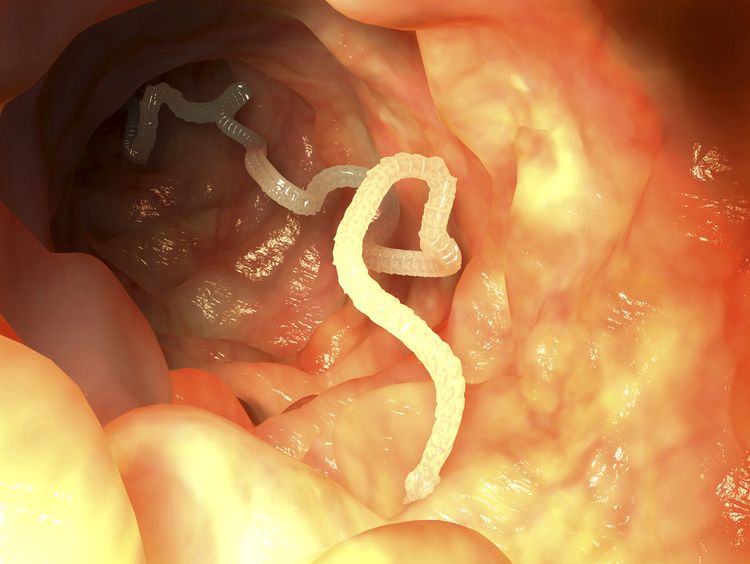Tapeworms in Dogs

Tapeworms are rarely a serious health risk, but they can pose problems ranging from irritation and itchiness to malnutrition and weight loss. These parasites are more common in puppies, especially those that are homeless. Although eradicating tapeworms is relatively easy, reinfection is likely unless additional measures are taken to avoid exposure. Understanding how a dog contracts tapeworms can help prevent it from happening.
What Are Tapeworms?
Tapeworms are ribbon-like flatworm parasites that live in the intestines of dogs, cats, and other animals. There are several varieties, but Dipylidium caninum and Taenia species are most common in dogs.
Immature worms must spend developmental time inside an intermediate host before being able to infest your dog. The flea serves this purpose for Dipylidium caninum, while Taenia species require time in a vertebrate animal—often rodents, rabbits, and the like.
The head of the tapeworm is equipped with hooks and suckers that are used to anchor it to the wall of the small intestine. Tapeworms do not have mouths or digestive systems; instead, they absorb nutrients through their body segments. Adult worms continue to add segments as long as they live, sometimes attaining lengths up to 20 meters!
Each segment contains both male and female reproductive organs. When mature, one segment can produce hundreds or even thousands of eggs. Segments farthest from the head are the most mature and once "ripe," they are shed from the worm's body and pass in the puppy or dog's feces where they can be eaten by an intermediate host.
Symptoms of Tapeworms in Dogs
Once outside the body, tapeworm segments can move independently like tiny inchworms until they dry out and become hardened, looking like grains of white rice. These dried segments are often one of the first signs of a tapeworm infection.
Infested dogs typically have segments stuck to the hair surrounding the anal area or in their bedding. Eventually, the segments dry and rupture, releasing the eggs they contain into the environment. Tapeworm eggs are passed and shed sporadically.
Tapeworms are rarely a medical problem and are usually considered an unpleasant annoyance. The moving proglottids may irritate the anal region, which may prompt dogs and puppies to excessively lick themselves or "scoot" their rear against the floor or ground. In rare cases, puppies may develop a gastrointestinal impaction due to the presence of large numbers of worms.
Causes of Tapeworms
If your puppy is infested with fleas, it is also likely to have Dipylidium tapeworms. This is the most common infection. There are two causes of tapeworms in dogs, as follows:
- Tapeworm eggs are ingested when a dog accidentally swallows a flea while chewing its skin and fur due to itching.
- Tapeworm eggs and/or segments are ingested when a dog eats rodents or rabbits that harbor the worms, which are generally the Taenia genus of tapeworms.
Diagnosing Tapeworms in Dogs
A veterinary fecal examination of a pup's stool may not reveal any eggs due to the sporadic nature of the tapeworm's life cycle. However, even if the test is inconclusive, a positive diagnosis can be made based on the owner's observation of segments (wet or dry).
Treatment and Prevention of Tapeworms
There are several safe and highly effective treatments for tapeworms, which may be administered as a pill, injection, or topical drops. Some must be prescribed by a veterinarian, while others are available over the counter.
A one-dose treatment will eliminate the tapeworms, but dogs can be reinfected immediately. Controlling fleas and preventing your dog from hunting outdoors are the best ways to prevent tapeworm infestation.
Prognosis for Dogs with Tapeworms
Tapeworms are easy to eradicate with treatment, but reinfection is the biggest concern. A dog with a longstanding, untreated tapeworm infestation may experience a dull coat and lethargy due to malnutrition, and it may lose weight or be unable to gain weight. Again, treatment is straightforward and will help dogs recover quickly,
Stray dogs with tapeworms may also be infected with other intestinal parasites and should be evaluated by a veterinarian to determine a comprehensive treatment plan.
Are They Contagious to Humans?
There is a human health risk associated with some tapeworms that affect dogs. People (usually children) can contract Dipylidium tapeworms from eating an infected flea.
While not common in dogs, a tapeworm species called Echinococcus granulosis tapeworms occasionally infect people in Alaska and the southwestern United States, causing cysts to form in the liver, lungs, and sometimes other organs.
Echinococcus multilocularis can be found in the north-central United States and Alaska. Although human infections are rare, they can be deadly due to the formation of destructive tumors in the liver.
Check with your veterinarian to see if these types of tapeworms pose a risk in your area.